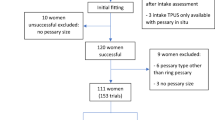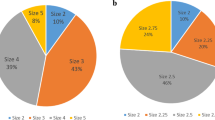Abstract
Introduction and hypothesis
The objective was to assess if specific reasons for unsuccessful pessary fitting have different predictive parameters.
Methods
This is a prospective observational case–control study of women with symptomatic pelvic organ prolapse (POP) choosing pessary treatment. All women underwent an interview, clinical examination, and 3D/4D transperineal ultrasound (TPUS). Groups were defined based on fitting outcome: successful, pessary dislodgment, failure to relieve POP symptoms, pain/discomfort, increased/de novo urinary incontinence, or other reasons. Clinical, demographic, and TPUS parameters were assessed in the prediction of different reasons for unsuccessful fitting and receiver operating characteristic (ROC) curves were constructed.
Results
A total of 162 women were assessed and 130 were included. Levator hiatal area (HA) on maximum Valsalva divided by ring pessary size (“Valsalva HARP ratio”) was a predictor of unsuccessful fitting (OR 3.00, 95% CI 1.15–7.81, p = 0.025) with an area under the ROC curve (AUC) of 0.62 (95% CI 0.50–0.74, p = 0.04). Predictors of pessary dislodgment were: complete avulsion (OR 24.20, 95% CI 2.46–237.84, p value 0.01) and Valsalva HARP ratio (OR 2.94, 95% CI 1.32–6.55, p value 0.01) with an area under the ROC curve (AUC) of 0.92 (95% CI 0.84–0.99, p = 0.00). No significant parameter was identified in the prediction of pain/discomfort. Solitary predominant posterior compartment POP was a predictor of failure to relieve POP symptoms (OR 20.00, 95% CI 3.48–115.02, p value 0.00; AUC 0.75, 95% CI 0.53–0.98, p = 0.03).
Conclusion
Complete avulsion and a small ring pessary with respect to the levator HA in Valsalva are predictors of pessary dislodgment, whereas solitary predominant posterior compartment POP is a predictor of failure to relieve POP symptoms.

Similar content being viewed by others
References
Gorti M, Hudelist G, Simons A. Evaluation of vaginal pessary management: a UK-based survey. J Obstet Gynaecol. 2009;29:129–31. https://doi.org/10.1080/01443610902719813.
Cundiff GW, Weidner AC, Visco AG, Bump RC, Addison WA. A survey of pessary use by members of the American Urogynecologic Society. Obstet Gynecol. 2000;95:931–5. https://doi.org/10.1016/s0029-7844(00)00788-2.
Bugge C, Adams EJ, Gopinath D, Reid F. Pessaries (mechanical devices) for pelvic organ prolapse in women. Cochrane Database Syst Rev. 2013;2013(2):CD004010. https://doi.org/10.1002/14651858.CD004010.pub3.
Fernando RJ, Thakar R, Sultan AH, Shah SM, Jones PW. Effect of vaginal pessaries on symptoms associated with pelvic organ prolapse. Obstet Gynecol. 2006;108:93–9. https://doi.org/10.1097/01.AOG.0000222903.38684.cc.
Clemons JL, Aguilar VC, Tillinghast TA, Jackson ND, Myers DL. Patient satisfaction and changes in prolapse and urinary symptoms in women who were fitted successfully with a pessary for pelvic organ prolapse. Am J Obstet Gynecol. 2004;190:1025–9. https://doi.org/10.1016/j.ajog.2003.10.711.
Ding J, Chen C, Song XC, Zhang L, Deng M, Zhu L. Changes in prolapse and urinary symptoms after successful fitting of a ring pessary with support in women with advanced pelvic organ prolapse: a prospective study. Urology. 2016;87:70–5. https://doi.org/10.1016/j.urology.2015.07.025.
Cheung RYK, Lee JHS, Lee LL, Chung TKH, Chan SSC. Vaginal pessary in women with symptomatic pelvic organ prolapse: a randomized controlled trial. Obstet Gynecol. 2016;128(1):73–80. https://doi-org.proxy.library.uu.nl/10.1097/AOG.0000000000001489.
Mutone MF, Terry C, Hale DS, Benson JT. Factors which influence the short-term success of pessary management of pelvic organ prolapse. Am J Obstet Gynecol. 2005;193:89–94. https://doi.org/10.1016/j.ajog.2004.12.012.
Manchana T. Ring pessary for all pelvic organ prolapse. Arch Gynecol Obstet. 2011;284:391–5. https://doi.org/10.1007/s00404-010-1675-y.
Panman CMCR, Wiegersma M, Kollen BJ, Burger H, Berger MY, Dekker JH. Predictors of unsuccessful pessary fitting in women with prolapse: a cross-sectional study in general practice. Int Urogynecol J. 2017;28:307–13. https://doi.org/10.1007/s00192-016-3107-4.
Mao M, Ai F, Zhang Y, Kang J, Liang S, Xu T, et al. Predictors for unsuccessful pessary fitting in women with symptomatic pelvic organ prolapse: a prospective study. BJOG. 2018;125(11):1434–40. https://doi.org/10.1111/1471-0528.15260.
Wu V, Farrell SA, Baskett TF, Flowerdew G. A simplified protocol for pessary management. Obstet Gynecol. 1997;90:990–4. https://doi.org/10.1016/s0029-7844(97)00481-x.
Yamada T, Matsubara S. Rectocoele, but not cystocoele, may predict unsuccessful pessary fitting. J Obstet Gynaecol. 2011;31:441–2. https://doi.org/10.3109/01443615.2011.577253.
Yang J, Han J, Zhu F, Wang Y. Ring and Gellhorn pessaries used in patients with pelvic organ prolapse: a retrospective study of 8 years. Arch Gynecol Obstet. 2018;298:623–9. https://doi.org/10.1007/s00404-018-4844-z.
Cheung RYK, Lee LLL, Chung TKH, Chan SSC. Predictors for dislodgment of vaginal pessary within one year in women with pelvic organ prolapse. Maturitas. 2018;108:53–7. https://doi.org/10.1016/j.maturitas.2017.11.008.
Clemons JL, Aguilar VC, Tillinghast TA, Jackson ND, Myers DL. Risk factors associated with an unsuccessful pessary fitting trial in women with pelvic organ prolapse. Am J Obstet Gynecol. 2004;190:345–50. https://doi.org/10.1016/j.ajog.2003.08.034.
Cundiff GW, Amundsen CL, Bent AE, Coates KW, Schaffer JI, Strohbehn K, et al. The PESSRI study: symptom relief outcomes of a randomized crossover trial of the ring and Gellhorn pessaries. Am J Obstet Gynecol. 2007;196(405):e1–8. https://doi.org/10.1016/j.ajog.2007.02.018.
Geoffrion R, Zhang T, Lee T, Cundiff GW. Clinical characteristics associated with unsuccessful pessary fitting outcomes. Female Pelvic Med Reconstr Surg. 2013;19:339–45. https://doi.org/10.1097/SPV.0b013e3182a26174.
Cheung RYK, Lee JHS, Lee LL, Chung TKH, Chan SSC. Levator ani muscle avulsion is a risk factor for expulsion within 1 year of vaginal pessary placed for pelvic organ prolapse. Ultrasound Obstet Gynecol. 2017;50:776–80. https://doi.org/10.1002/uog.17407.
Turel Fatakia F, Pixton S, Caudwell Hall J, Dietz HP. Predictors of successful ring pessary use in women with pelvic organ prolapse. Aust N Z J Obstet Gynaecol. 2020;60(4):579–84. https://doi.org/10.1111/ajo.13152.
Bump RC, Mattiasson A, Bo K, Brubaker LP, DeLancey JOL, Klarskov P, et al. The standardization of terminology of female pelvic organ prolapse and pelvic floor dysfunction. Am J Obstet Gynecol. 1996;175:10–7. https://doi.org/10.1016/S0002-9378(96)70243-0.
Mao M, Ai F, Zhang Y, Kang J, Liang S, Xu T, et al. Changes in the symptoms and quality of life of women with symptomatic pelvic organ prolapse fitted with a ring with support pessary. Maturitas. 2018;117:51–6. https://doi.org/10.1016/j.maturitas.2018.09.003.
Deng M, Ding J, Ai F, Zhu L. Clinical use of ring with support pessary for advanced pelvic organ prolapse and predictors of its short-term successful use. Menopause. 2017;24:954–8. https://doi.org/10.1097/GME.0000000000000859.
Dietz HP. Ultrasound in the assessment of pelvic organ prolapse. Best Pract Res Clin Obstet Gynaecol. 2019;54:12–30. https://doi.org/10.1016/j.bpobgyn.2018.06.006.
Ritter F, Boskamp T, Homeyer A, Laue H, Schwier M, Link F, et al. Medical image analysis. IEEE Pulse. 2011;2:60–70. https://doi.org/10.1109/MPUL.2011.942929.
Dietz HP. Pelvic floor ultrasound—Atlas and textbook. 2016. London: Springer.
Vittinghoff E, McCulloch CE. Relaxing the rule of ten events per variable in logistic and cox regression. Am J Epidemiol. 2007;165:710–8. https://doi.org/10.1093/aje/kwk052.
Nagelkerke NJD. A note on a general definition of the coefficient of determination. Biometrika. 1991;78:691–2.
Hosmer ADW Jr, Lemeshow S, Sturdivant RX. Applied logistic regression. 3rd ed. Hoboken: Wiley; 2013.
Friedman T, Eslick GD, Dietz HP. Risk factors for prolapse recurrence: systematic review and meta-analysis. Int Urogynecol J. 2018;29:13–21. https://doi.org/10.1007/s00192-017-3475-4.
Oliver R, Thakar R, Sultan AH. The history and usage of the vaginal pessary: a review. Eur J Obstet Gynecol Reprod Biol. 2011;156:125–30. https://doi.org/10.1016/j.ejogrb.2010.12.039.
Funding
The study was part of the GYNecological Imaging using 3D UltraSound (GYNIUS) project with number 15301, which is financed by the Dutch Research Council (NWO). Philips contributed to the project by providing the ultrasound machine and TOMTEC provided image analysis software, which was not used for the current paper. The funding sources had no involvement in the study design, analysis, interpretation of data, report writing or preparation of this publication.
Author information
Authors and Affiliations
Contributions
C. Manzini: project development, data collection, data analysis and interpretation, manuscript writing and editing; C.H. van der Vaart: project development, data interpretation, manuscript editing; F. van den Noort: analysis tool development, manuscript editing; A.T.M. Grob: data interpretation, manuscript editing; M.I.J. Withagen: project development, data interpretation, manuscript editing.
Corresponding author
Ethics declarations
Conflicts of interest
Authors declare that they have no conflicts of interest.
Additional information
Publisher’s note
Springer Nature remains neutral with regard to jurisdictional claims in published maps and institutional affiliations.
Appendix 1
Appendix 1
Rights and permissions
About this article
Cite this article
Manzini, C., van der Vaart, C.H., van den Noort, F. et al. Pessary fitting for pelvic organ prolapse: parameters associated with specific reasons for failure. Int Urogynecol J 33, 2037–2046 (2022). https://doi.org/10.1007/s00192-021-05053-w
Received:
Accepted:
Published:
Issue Date:
DOI: https://doi.org/10.1007/s00192-021-05053-w




